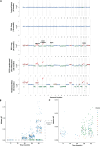Clonal driver neoantigen loss under EGFR TKI and immune selection pressures
- PMID: 39972134
- PMCID: PMC11946900
- DOI: 10.1038/s41586-025-08586-y
Clonal driver neoantigen loss under EGFR TKI and immune selection pressures
Abstract
Neoantigen vaccines are under investigation for various cancers, including epidermal growth factor receptor (EGFR)-driven lung cancers1,2. We tracked the phylogenetic history of an EGFR mutant lung cancer treated with erlotinib, osimertinib, radiotherapy and a personalized neopeptide vaccine (NPV) targeting ten somatic mutations, including EGFR exon 19 deletion (ex19del). The ex19del mutation was clonal, but is likely to have appeared after a whole-genome doubling (WGD) event. Following osimertinib and NPV treatment, loss of the ex19del mutation was identified in a progressing small-cell-transformed liver metastasis. Circulating tumour DNA analyses tracking 467 somatic variants revealed the presence of this EGFR wild-type clone before vaccination and its expansion during osimertinib/NPV therapy. Despite systemic T cell reactivity to the vaccine-targeted ex19del neoantigen, the NPV failed to halt disease progression. The liver metastasis lost vaccine-targeted neoantigens through chromosomal instability and exhibited a hostile microenvironment, characterized by limited immune infiltration, low CXCL9 and elevated M2 macrophage levels. Neoantigens arising post-WGD were more likely to be absent in the progressing liver metastasis than those occurring pre-WGD, suggesting that prioritizing pre-WGD neoantigens may improve vaccine design. Data from the TRACERx 421 cohort3 provide evidence that pre-WGD mutations better represent clonal variants, and owing to their presence at multiple copy numbers, are less likely to be lost in metastatic transition. These data highlight the power of phylogenetic disease tracking and functional T cell profiling to understand mechanisms of immune escape during combination therapies.
© 2025. The Author(s).
Conflict of interest statement
Competing interests: M.A.B. has consulted for Achilles Therapeutics. J.L.R. reports speaker fees from Boehringer Ingelheim and GlaxoSmithKline and consults for Achilles Therapeutics Ltd. J.L.R. and has filed patents for cancer early detection (PCT/EP2023/076521 and PCT/EP2023/076511) using systemic TCR-seq data, on which S.G. is a co-inventor. A.T.G. and P.K. are former or current employees of Invitae or ArcherDx and report stock ownership. D.A.M. reports speaker fees from AstraZeneca, Eli Lilly and Takeda; consultancy fees from AstraZeneca, Thermo Fisher Scientific, Takeda, Amgen, Janssen, MIM Software, Bristol Myers Squibb (BMS) and Eli Lilly; and has received educational support from Takeda and Amgen. C.A. has received speaking honoraria or expenses from Novartis, Roche, AstraZeneca and BMS; has patents issued to detect tumour recurrence (PCT/GB2017/053289) and for methods for lung cancer detection (PCT/US2017/028013) and is co-inventor to a patent application to determine methods and systems for tumour monitoring (PCT/EP2022/077987); and is a current employee of AstraZeneca. C.T.H. has received speaker fees from AstraZeneca. K.L. has a patent on indel burden and CPI response pending and outside of the submitted work, speaker fees from Roche tissue diagnostics, research funding from CRUK TDL/Ono/LifeArc alliance and Genesis Therapeutics, and consulting roles with Monopteros Therapeutics and Kynos Therapeutics, all outside of the submitted work. M.D.F. acknowledges grant support from CRUK, AstraZeneca, Boehringer Ingelheim, MSD and Merck; is an advisory board member for Transgene; and has consulted for Achilles, Amgen, AstraZeneca, Bayer, Boxer, Bristol Myers Squibb, Celgene, EQRx, Guardant Health, Immutep, Ixogen, Janssen, Merck, MSD, Nanobiotix, Novartis, Oxford VacMedix, Pharmamar, Pfizer, Roche, Takeda and UltraHuman. T.A. reports employment and stock options with Ellipses Pharma, and is an advisory board member for Engitix, iOnctura, Labgenius and Further Group. S.R.H. is the co-inventor of the patents WO2015185067 and WO2015188839 for the barcoded MHC technology which is licenced to Immudex and co-inventor of the licensed patent for Combinatorial encoding of MHC multimers (EP2088/009356), licensee: Sanquin, NL. S.A.Q. is a co-founder, stockholder and Chief Scientific Officer of Achilles Therapeutics. S.V. is a co-inventor to a patent of methods for detecting molecules in a sample (patent no. 10,578,620). N.M. has stock options in and has consulted for Achilles Therapeutics and holds a European patent in determining HLA LOH (PCT/GB2018/052004), and is a co-inventor to a patent to identifying responders to cancer treatment (PCT/GB2018/051912). C.S. acknowledges grant support from AstraZeneca, Boehringer Ingelheim, Bristol Myers Squibb, Pfizer, Roche-Ventana, Invitae (previously ArcherDx Inc.—collaboration in minimal residual disease sequencing technologies) and Ono Pharmaceutical. He is an AstraZeneca Advisory Board member and Chief Investigator for the AZ MeRmaiD 1 and 2 clinical trials and is also Co-Chief Investigator of the NHS Galleri trial funded by GRAIL and a paid member of GRAIL’s Scientific Advisory Board. He receives consultant fees from Achilles Therapeutics (also SAB member), Bicycle Therapeutics (also a SAB member), Genentech, Medicxi, Roche Innovation Centre–Shanghai, Metabomed (until July 2022) and the Sarah Cannon Research Institute; had stock options in Apogen Biotechnologies and GRAIL until June 2021 and at present has stock options in Epic Bioscience and Bicycle Therapeutics, and has stock options and is co-founder of Achilles Therapeutics. C.S. holds patents relating to assay technology to detect tumour recurrence (PCT/GB2017/053289), targeting neoantigens (PCT/EP2016/059401), identifying patent response to immune checkpoint blockade (PCT/EP2016/071471), determining HLA LOH (PCT/GB2018/052004), predicting survival rates of patients with cancer (PCT/GB2020/050221), identifying patients who respond to cancer treatment (PCT/GB2018/051912), US patent relating to detecting tumour mutations (PCT/US2017/28013), methods for lung cancer detection (US20190106751A1) and both a European and US patent related to identifying insertion/deletion mutation targets (PCT/GB2018/051892), and is co-inventor to a patent application to determine methods and systems for tumour monitoring (PCT/EP2022/077987).
Figures











References
MeSH terms
Substances
Grants and funding
LinkOut - more resources
Full Text Sources
Medical
Research Materials
Miscellaneous

